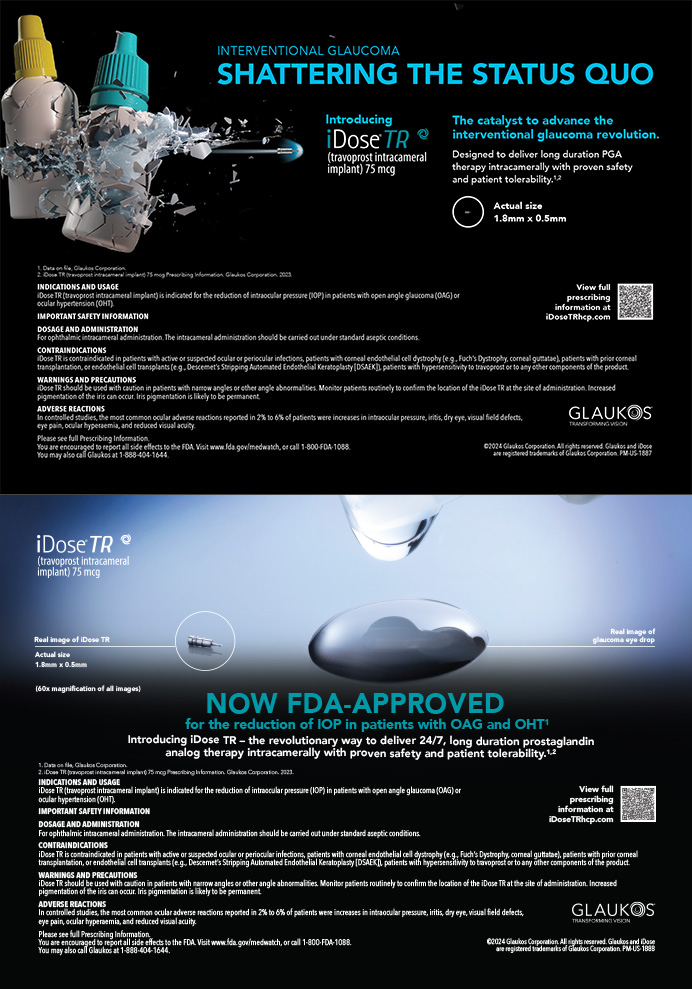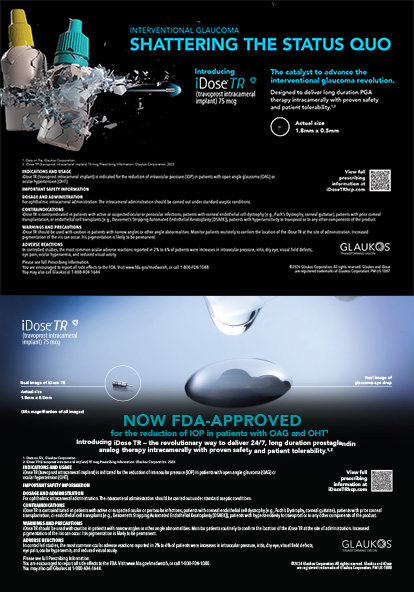

Femtosecond Laser-Assisted Stromal Lenticule Addition Keratoplasty for the Treatment of Advanced Keratoconus: a Preliminary Study
Mastropasqua L, Nubile M, Salgari N, Mastropasqua R1
ABSTRACT SUMMARY
When spectacles or contact lenses fail to provide useful visual function, surgical intervention may be the only means by which to improve the visual acuity of a patient with keratoconus.2-5 Procedures to correct keratoconus include penetrating or deep anterior lamellar keratoplasty, intrastromal corneal ring segment implantation, and CXL combined with PRK or phototherapeutic keratectomy (PTK).
The introduction of small-incision lenticule extraction to correct refractive error led to a hypothesis that stromal lenticules could be preserved and implanted to reverse refractive treatment or to treat other forms of ametropia. The goal of a novel surgical technique called stromal lenticule addition keratoplasty (SLAK) is to improve stromal thickness and induce central corneal flattening by implanting stromal lenticules in the eyes of patients with advanced keratoconus.
Mastropasqua and colleagues’ noncomparative interventional case series included 10 eyes of 10 patients with stable stage 3 or stage 4 central keratoconus. The procedure by which a femtosecond laser cuts a stromal flap was modified to instead produce an intrastromal pocket around the marked center of the cornea. Investigators then implanted negative meniscus lenticules previously prepared from donor corneas. The researchers measured postoperative uncorrected distance visual acuity (UDVA), corrected distance visual acuity (CDVA), manifest refraction, and topography.
Six months after surgery, UDVA had improved significantly from 1.58 ±0.36 to 1.22 ±0.37 logMAR (P = .024), and CDVA had improved from 1.07 ±0.17 to 0.70 ±0.23 logMAR (P = .007). All study eyes showed generalized flattening at 6 months, with a change in mean anterior keratometry values from 58.69º ±3.59º before surgery to 53.59º ±3.50º. Central corneal thickness increased from a mean of 406 ±42 µm preoperatively to 453 ±39 µm at 6 months. No immediate perioperative or long-term complications related to SLAK were observed.
STUDY IN BRIEF
• A small, noncomparative, interventional case series investigated the effect of a novel treatment for advanced keratoconus: femtosecond laser–assisted stromal lenticule addition keratoplasty (SLAK). The researchers found SLAK to improve visual acuity and corneal shape.
WHY IT MATTERS
Treatment options for keratoconus continue to expand as investigators search for safe and effective ways to improve affected patients’ quality of life. The results of this study suggest that SLAK is a safe and clinically efficient method of improving corneal shape and visual acuity in patients with advanced keratoconus.
DISCUSSION
Studies have validated the integration and survival of transplanted refractive lenticules in host corneas.6-8 Ganesh and Brar expanded on this work when they implanted a doughnut-shaped myopic lenticule around the cone and midperiphery to induce a less hyperprolate corneal morphology and cause relative flattening in six eyes.9 Mastropasqua and colleagues implanted a negative meniscus-shaped stromal lenticule to evaluate SLAK for the treatment of advanced, stable keratoconus.
Six months after surgery, they found a statistically significant improvement in UDVA, CDVA, and spherical equivalent, with nine of 10 eyes showing an increase in CDVA ranging from 1 to 3 Snellen lines. All eyes demonstrated improvement on topographic analysis, including a reduction in anterior corneal curvature, an increase in central corneal thickness, and an improvement in corneal sphericity values.
Among the limitations of the study are a small sample size and the inclusion of only central and stable keratoconus. The majority of keratoconus cases are eccentric. Further investigation is needed to determine whether SLAK, with the lenticule profile used in this study, is safe and effective in patients with eccentric keratoconus. It has been proposed that combining CXL with this tissue-addition approach can further improve visual acuity and topographic analysis in the treatment of keratoconus.9 After stromal thickness is increased with SLAK, patients with advanced keratoconus whose pachymetry readings are below the recommended values for CXL could then receive CXL treatment. Mastropasqua and colleagues suggested that combining SLAK with CXL might also be beneficial in progressive keratoconus; this would expand the treatment options for this patient population.
Combined Transepithelial Phototherapeutic Keratectomy and Conventional Photorefractive Keratectomy Followed Simultaneously by Corneal Crosslinking for Keratoconus: Cretan Protocol Plus
Grentzelos M, Kounis G, Diakonis VF, et al10
ABSTRACT SUMMARY
Although CXL has been shown to strengthen the cornea and halt progressive ectasia, the procedure does not significantly improve visual acuity.11 Grentzelos and colleagues studied the 1-year visual, refractive, and topographic outcomes in patients undergoing combined transepithelial PTK, conventional PRK, and CXL.
This prospective case series included 53 eyes of 43 patients (30 men and 13 women); mean age was of 30.8 ±7.9 years (range, 18–39 years) and average preoperative corneal thickness was 467 ±29 µm (range, 410–526 µm). All patients underwent epithelial removal via PTK using the Allegretto WaveLight excimer laser system (Alcon). A 6.5-mm optical zone was extended to between 8 and 9 mm with a spatula, and a 50-µm ablation was performed. Next, they received conventional PRK with the excimer laser using a maximum optical zone of 5.5 mm and a maximum ablation depth of 50 µm (average, 22 ±10 µm). Finally, patients underwent CXL with a 30-minute irradiance of 5.4 J/cm2 total.
STUDY IN BRIEF
• Investigators evaluated the safety and efficacy of transepithelial PTK combined with conventional PRK and CXL (Cretan protocol plus) in patients with progressive keratoconus. The researchers found the combined procedure to be effective in improving UCVA and BCVA and stabilizing the cornea in this patient population.
WHY IT MATTERS
There is no standard algorithm for the treatment of irregular astigmatism in keratoconus during or after CXL. This study demonstrated a safe and effective method by which to improve visual acuity and stabilize the cornea.
One year after treatment, mean UCVA had improved from 0.98 ±0.63 to 0.39 ±0.35 logMAR, and mean BCVA had improved from 0.20 ±0.23 to 0.08 ±0.16 logMAR. Additionally, mean spherical equivalent improved significantly from -4.67 ±4.00 D preoperatively to -2.24 ±2.81 D at 1 year, with a corresponding improvement in mean steep and flat keratometry. At the study’s conclusion at 12 months, 28 eyes (51%) had gained at least 1 line of BCVA. Specifically, seven eyes (13%) gained 3 or more lines, nine eyes (16%) gained 2 lines, and 12 eyes (22%) gained 1 line. Twenty-six eyes (47%) neither gained nor lost lines of vision. One eye (2%) lost 2 lines of vision.
DISCUSSION
Recent studies have shown that combining CXL with a secondary procedure (eg, topography-guided PRK, intrastromal corneal ring segment implantation, or phakic IOL implantation) can improve BCVA and UCVA.12,13 An earlier report from the Cretan study described encouraging results in patients with pellucid marginal degeneration who underwent combined transepithelial PTK, PRK, and CXL.14 The investigators chose conventional instead of topography-guided PRK because transepithelial PTK acts as a customized treatment, given the thinner epithelium at the apex in keratoconic eyes. A 50-µm PTK ablation removes a small amount of stroma at the corneal apex, resulting in a more regular surface (Cretan protocol), which has been shown to significantly improve UCVA, BCVA, and keratometry readings.15,16
Grentzelos and colleagues showed that the combined procedure can not only stabilize but also improve the BCVA of patients with keratoconus. The statistically significant improvement in BCVA and UCVA observed 1 month after treatment remained significant at all follow-up intervals. Similar improvements were seen with regard to mean flat and steep keratometry, mean astigmatism, and spherical equivalent. Although many techniques exist for treating irregular astigmatism, it is worth noting that transepithelial PTK in conjunction with conventional PRK can be performed using a broad range of laser platforms. Studies with longer follow-up intervals are needed to assess the long-term outcomes of the combined procedure.
1. Mastropasqua L, Nubile M, Salgari N, Mastropasqua R. Femtosecond laser-assisted stromal lenticule addition keratoplasty for the treatment of advanced keratoconus: a preliminary study. J Refract Surg. 2018;34(1):36-44.
2. Arnalich-Montiel F, Alió Del Barrio JL, Alió JL. Corneal surgery in keratoconus: which type, which technique, which outcomes? Eye Vis (Lond). 2016;3:2.
3. Parker JS, van Dijk K, Melles GR. Treatment options for advanced keratoconus: a review. Surv Ophthalmol. 2015;60(5):459-480.
4. Henein C, Nanavaty MA. Systematic review comparing penetrating keratoplasty and deep anterior lamellar keratoplasty for management of keratoconus. Cont Lens Anterior Eye. 2017;40(1):3-14.
5. Mastropasqua L. Collagen cross-linking: when and how? A review of the state of the art of the technique and new perspectives. Eye Vis (Lond). 2015;2:19.
6. Angunawela RI, Riau AK, Chaurasia SS, et al. Refractive lenticule re-implantation after myopic ReLEx: a feasibility study of stromal restoration after refractive surgery in a rabbit model. Invest Ophthalmol Vis Sci. 2012;53(8):4975-4985.
7. Riau AK, Angunawela RI, Chaurasia SS, et al. Reversible femtosecond laser-assisted myopia correction: a non-human primate study of lenticule re-implantation after refractive lenticule extraction. PLoS One. 2013;8(6):e67058.
8. Mohamed-Noriega K, Toh KP, Poh R, et al. Cornea lenticule viability and structural integrity after refractive lenticule extraction (ReLEx) and cryopreservation. Mol Vis. 2011;17:3437-3449.
9. Ganesh S, Brar S. Femtosecond intrastromal lenticular implantation combined with accelerated collagen cross-linking for the treatment of keratoconus—initial clinical result in 6 eyes. Cornea. 2015;34(10):1331-1339.
10. Grentzelos MA, Kounis GA, Diakonis VF, et al. Combined transepithelial phototherapeutic keratectomy and conventional photorefractive keratectomy followed simultaneously by corneal crosslinking for keratoconus: Cretan protocol plus. J Cataract Refract Surg. 2017;43(10):1257-1262.
11. Kymionis GD, Grentzelos MA, Liakopoulos DA, et al. Long-term follow-up of corneal collagen cross-linking for keratoconus—the Cretan study. Cornea. 2014;33(10):1071-1079.
12. Kymionis GD, Grentzelos MA, Portaliou DM, et al. Corneal collagen cross-linking (CXL) combined with refractive procedures for the treatment of corneal ectatic disorders: CXL plus. J Refract Surg. 2014;30(8):566-576.
13. Abdelmassih Y, El-Khoury S, Chelala E, et al. Toric ICL implantation after sequential intracorneal ring segments implantation and corneal cross-linking in keratoconus: 2-year follow-up. J Refract Surg. 2017;33(9):610-616.
14. Kymionis GD, Grentzelos MA, Plaka AD, et al. Simultaneous conventional photorefractive keratectomy and corneal collagen cross-linking for pellucid marginal corneal degeneration. J Refract Surg. 2014;30(4):272-276.
15. Kymionis GD, Grentzelos MA, Kounis GA, et al. Combined transepithelial phototherapeutic keratectomy and corneal collagen cross-linking for progressive keratoconus. Ophthalmology. 2012;119(9):1777-1784.
16. Kymionis GD, Grentzelos MA, Kankariya VP, et al. Long-term results of combined transepithelial phototherapeutic keratectomy and corneal collagen crosslinking for keratoconus: Cretan protocol. J Cataract Refract Surg. 2014;40(9):1439-1445.




